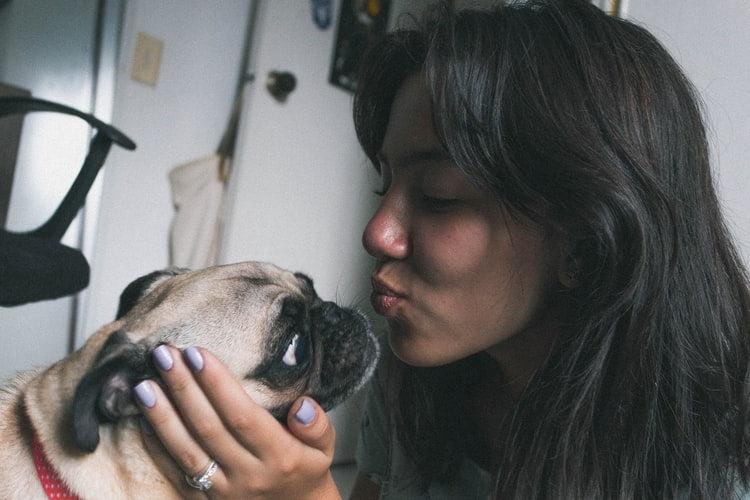In this blog, we learn all about the love hormone oxytocin and how our beloved fur babies can help release this amazing chemical in our bodies. We’ll also discover that dogs have a similar hormonal response to us when it comes to oxytocin, which is how they form such strong attachments to humans!
Oxytocin And Dogs: What Looking Into Your Dog’s Eyes Can Do!

With Valentine’s Day just around the corner, it can make us all feel the love in the air that little bit more.
Storefronts, restaurants, and movie theatres start to become the breeding ground for romance, love, first dates, and big red hearts, reminding us that Cupid is coming. But, instead of just thinking about your significant other during this romantic month, you could also get the same loving emotions from your furry friend, too!
So, what do we mean?
Well, from countless studies, it is believed that when we look into the eyes of someone we love, our bodies fill with a hormone called Oxytocin, or in other words, the ‘love hormone’.
Now, for some of us, our fur babies bring us just as much love – if not more – than any of the significant people in our lives. This means those big puppy dog eyes could be filling your body with as much love as any partner or spouse!

Oxytocin And Dogs
As said above, oxytocin can have many other names; the love hormone, the cuddle hormone, or the love drug – but, whatever you call it, this clever hormone is produced by the body, playing a huge role in our ability to form bonds with each other. Acting as a neurotransmitter in the brain, oxytocin influences a lot of the things we do, think, and feel.
For example, when a woman gives birth to a child or breastfeeds a baby, the body will be flooded with oxytocin – helping to create that unbreakable mother/child bond. It also plays a vital role in sex, and the bond between individuals both socially and intimately – it’s the ultimate natural high.
Interestingly, studies have shown that people who are single have lower levels of oxytocin compared to those in a relationship – but does that include individuals who have an amazing bond with their fur babies?
Well, according to one study, there is also a huge relationship between oxytocin and dogs – we can actually feel these emotions and produce oxytocin when we look into the eyes of our dog, too.
The Study
According to a study in Japan, they discovered that time spent gazing into the eyes of a dog has a large effect on the levels of oxytocin produced by the body.
Biologists Miho Nagasawa and Takefumi Kikusui found that when a person looked into their dog’s eyes for longer than 2.5 minutes, their levels of oxytocin rose by 20% – compared to when they looked into the eyes for 45 seconds or less.
So, with that in mind, it would lead us to the conclusion that the longer we stare into those big puppy dog eyes, the more our bodies react – filling with the desire to care, love and protect – just as a new mother would for her baby, which leads us to the next part of the study…
There is a theory called the ‘positive feedback loop’, where it is believed that different individuals can trigger the release of oxytocin in each other. For example, a new parent looks into the eyes of their newborn child and immediately their body will flood with oxytocin – which will, in turn, cause the same reaction in the child. This continues to happen in a cycle, giving the parent and child more rushes of the ‘love hormone’ around their bodies, filling them both with immense feelings of love.
After discovering these findings, the team looked deeper into this oxytocin connection – wondering if this ‘positive feedback loop’ could also happen between human and canine…
They decided to give each dog a boost of oxytocin via a nasal spray mist and were led into ‘playrooms’ with a mixture of their owner and strangers. Naturally, the dogs went straight to their owners, stared into their eyes for a long period of time and the levels of oxytocin rose – showing this unique relationship between oxytocin and dogs.

However, this time, they also discovered that female dogs had a larger reaction than male dogs. These female dogs spent more time gazing into the eyes of their female human friend – more so than the male humans in the same room.
During these long staring interactions, the human female oxytocin levels rose in response, too. Although we don’t fully understand why, it may be linked to the natural caring response both female dogs and humans have when it comes to childbearing – without this connection, it would make parenthood very difficult.
How Dogs Utilize Oxytocin
Just as we produce oxytocin to solidify and form social bonds, our dogs also naturally react this way, too – but it also helps when it comes to understanding and reacting to social cues.
Social cues are actions or moments that help us participate in social interactions like a conversation, argument, or danger. These interactions don’t always have to be verbal either, they can be expressed through a simple gesture or a facial expression. We use these important cues in our everyday lives; when to end a conversation, when to start a new one, or just how to behave in social surroundings.
Think of it this way; a frown and a smile tell us two different emotions, right? Our ‘social cue recognizer’ will help us react in the correct way to either of these visual cues.
So, what about our dogs? Well, as a matter of fact, our canine companions also have the ability to read and react to social cues, using the oxytocin hormone – which is how the dog became ‘man’s best friend’.
According to Dr. Nicole Grygolunas, “There is growing evidence that dogs can establish close relationships and emotional bonds with humans, which can be as strong as the human-infant attachment bond.”
She states, “Studies have even suggested that dogs with higher oxytocin levels exhibited more confident behaviors and were less stressed in threatening situations when their owners were around. What’s more, the interaction between dogs and humans not only increases oxytocin in both species, but produce anti-stress effects. It appears that when owners and dogs sense each other’s positive emotional states, it further enhances these calming effects, facilitating friendly interactions, increased trust and decreased levels of anxiety.”
Final Thoughts on Oxytocin And Dogs
So, there you have it – looking into those beautiful puppy dog eyes can make the ‘love hormone’ flood your body and leave you and your pup feeling full of love and affection. Normally thought of as just something us humans feel for each other, we now know that it can spread into the relationships we share with our favorite furry friends, too – so the love you have for your pet can feel just as strong as your own child. This human-dog oxytocin connection is more important than we realized.
Sources
Author Nagasawa, Miho and Mogi, Kazutaka and Kikusui, Takefumi “Attachment Between Humans And Dogs” Wiley Online Library, Sep 16. 2009 https://onlinelibrary.wiley.com/doi/full/10.1111/j.1468-5884.2009.00402.x
“Oxytocin” You And Your Hormones, Dec. 2020 https://www.yourhormones.info/hormones/oxytocin/
 B
B



